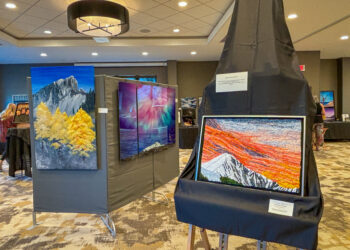By Jeannie Counce EBS CONTRIBUTOR
Just because hunting season is over, it doesn’t mean you should stop watching the wonders of Montana wildlife. In fact, the crisp blue winter skies and snow-covered mountains are an ideal backdrop for raptor watching.
These aerial predators—eagles, owls, hawks and falcons—are capable of fantastic in-flight maneuvers that are more visible in the stark white winter landscape.
Since 1988, Montana Raptor Conservation Center has been rehabilitating injured birds of prey from across the state and educating the community on the importance of raptors in the environment. Whether you’re carving turns on the ski hill, crunching along on a trail or après-skiing by a big picture window, the experts at MRCC suggest you watch for these seasonal raptor behaviors.
Look for rough-legged hawks, which have flown south from Alaska and Canada to winter in this area. Because they live and breed in the arctic—between latitudes of 61 and 76 degrees north—rough-legged hawks are one of the few hawk species to have feathers down to their feet for insulation.
While up north, these hawks feast on lemmings and nest on cliff sides. Here in the Lower 48, they can be found in open country hunting small rodents.
“The weather influences how long they stay, but rough-legged hawks usually begin heading back to the tundra sometime in March,” said MRCC Director Becky Kean.
Gyrfalcons are another arctic species that sometimes make their way to Montana for the winter. The largest falcon in the world, the gyrfalcon is as fast as a peregrine, but is silvery white with black spotting. They can also appear in shades of gray and dark brown.
“Their hunting areas and diet are similar to the rough-legged hawk, but their hunting style is typically to spot prey in flight or from a high perch and strike from above, driving it to the ground,” MRCC’s Assistant Director Jordan Spyke said. “You can also see them perched on the ground.”
The ultimate winter migrant is the snowy owl, according to Kean. “People love to spot these beautiful, curiously white owls, but they can be elusive,” she said. Their appearance here depends on several factors, including their population and that of their food source—lemmings and ptarmigan—as well as weather patterns.
“Usually, the first-year birds make the trip south while older birds stay on the tundra,” Kean explained. “So, when we see snowy owls, they are young and pretty green.” That inexperience can get them into trouble.
“They’re not used to humans, and don’t realize the danger of things like moving cars. We’ve treated a few snowy owls over the years, but they don’t do well in captivity,” Kean said. “As magnificent as they are, I’d rather see one out in the wild than up-close in the hospital setting.”
The heaviest North American owl—great grays are taller, but lighter—snowy owls are white with piercing yellow eyes and a thick white mustache. Both young males and females have black or brown markings, but the patterns are usually heavier on the females, making them look more variegated. Like rough-legged hawks, snowy owls have feathered feet, which make them look wide and sturdy at the base. They often perch on rises on the ground, hay bales and fence posts, and fly close to the ground.
There is no shortage of bald eagles in southwest Montana this time of year, according to Spyke. “They are pretty easy to spot and never disappoint,” he said. Bald eagles congregate near flowing water, so watch for them near rivers, streams and dams.
“This is also a good time to scout out eagle nests because there are no leaves on the trees,” Spyke said. “The nests are gigantic—5 to 6 feet in diameter and 2 to 4 feet deep—so they are easy to spot. Remember these locations and watch for young fledglings in flight training this spring.”
A version of this article first appeared in the Jan. 6, 2017, edition of EBS.
Jeannie Counce is a Bozeman-based writer and editor. She is a board member of the nonprofit Montana Raptor Conservation Center, which has a mission to improve the welfare of raptors across Montana through rehabilitation of injured birds, community education and partnerships for raptor conservation and research.














